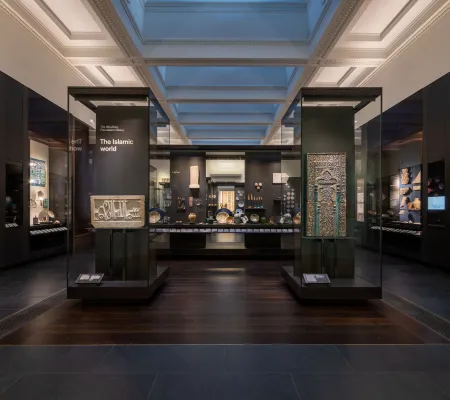In October 2018, the British Museum reintroduced its world-renowned collection of Islamic art and material culture in two completely refurbished rooms situated within the heart of the museum. Spanning a region from West Africa to the Malay world and dating from the 7th century to the present day, the displayed works and their presentation embody a more comprehensive and nuanced view of Islamic visual culture than was previously feasible, enabling the museum to represent its vast collections through a lens more in line with issues and concerns of the present day. More than inducing an appreciation of art or presenting a historical narrative, as had been the objective in earlier generations, the team at the British Museum recognized that museums today are often called upon to use objects as a mediator of culture. By shifting our framework paradigm from “Islamic art” to “Islamic visual culture”, the museum could exhibit works of great magnificence in dialogue with objects of everyday life, including arts of the book, textiles, musical instruments and more. The creation of the Albukhary Foundation Gallery of the Islamic World thus made it possible to feature the engaging and multifaceted narratives that these works tell us about the peoples of the Islamic world, as well as the ideas, technologies, and interactions that inspired their visual culture.
This talk will explore the making of the British Museum’s Albukhary Foundation Gallery from a curatorial and “behind-the-scenes” perspective, taking into account the evolving (sometimes contested) definition of the “museum” today and the continuing pressure to address the question “What is Islam?” while also embracing the expressions of diverse faiths, political formations, and ethnicities grouped under the broad umbrella of Islamic visual culture. It will examine how the overall display at the British Museum changed from its previous 30-year installation to present a complete reconception of Islamic art and material culture, and how our team of curators, conservators, designers and other stakeholders worked to reconcile the challenges associated with trying to represent such a diverse set of objects and images as part of a coherent entity.
Inaugurated in an era where the concepts of Islam, Islamic, and Muslim “culture” are often used interchangeably and without much interrogation, the new Albukhary Foundation Gallery of the Islamic World uses the vast collections of the British Museum to engage publicly with objects through both the conceptual framework of Islamic culture and the lived experience of Muslims and others living in Islamic lands and diaspora. The critical epistemic shift reflected in its reconceived narrative makes the gallery accessible to all, regardless of their preexisting familiarity with Islam or cultures within the Islamic world.
Ladan Akbarnia is the newly appointed Curator of South Asian and Islamic Art at the San Diego Museum of Art and a specialist on the art of medieval Iran and Central Asia. Her research projects and interests include cross-cultural transmissions between Iran and East Asia; Persianate drawings; the relationship between oral tradition and visual culture; and contemporary Middle Eastern art. She recently left the British Museum, where she was Curator and Assistant Keeper of the Islamic Collections for almost 10 years, and one of the lead curators for the Albukhary Foundation Gallery of the Islamic World, which opened in October 2018. She was a contributor to its two accompanying publications and is now working on a book about Persianate drawings at the British Museum (Gingko Library, forthcoming 2021). She is now three weeks into her new role at the San Diego Museum of Art and becoming fast acquainted with the new collection under her care in anticipation of new projects related to its cultivation and display, special exhibitions, and related programs.
Before going to the British Museum in 2010, she was Hagop Kevorkian Associate Curator of Islamic Art at the Brooklyn Museum, where she organized a reinstallation of the Islamic collection and the exhibition Light of the Sufis: The Mystical Arts of Islam with its accompanying catalogue (2009); and acquired the collection’s first works of Middle Eastern contemporary art. Previously, she served as Executive Director of the Iran Heritage Foundation, a nonprofit charity dedicated to the preservation of Iran’s culture and languages, and as Consulting Curator for the Aga Khan Museum Collection. She received her Ph.D. from Harvard University.


